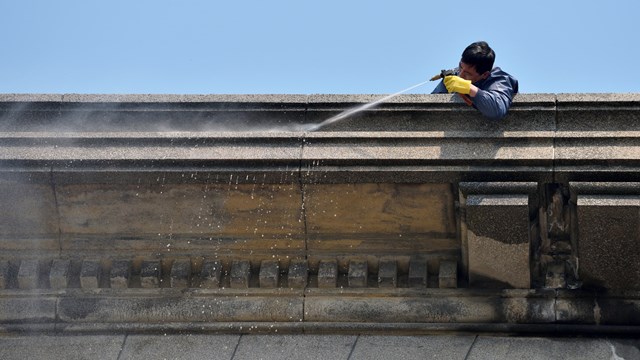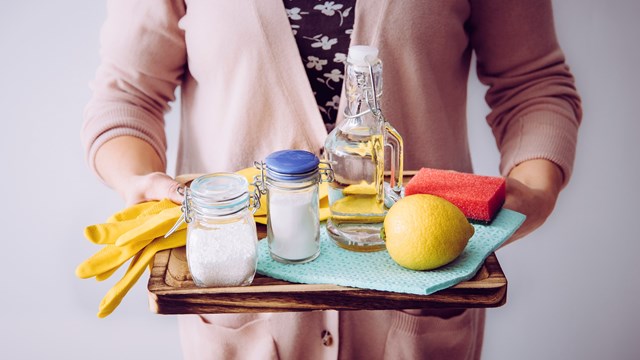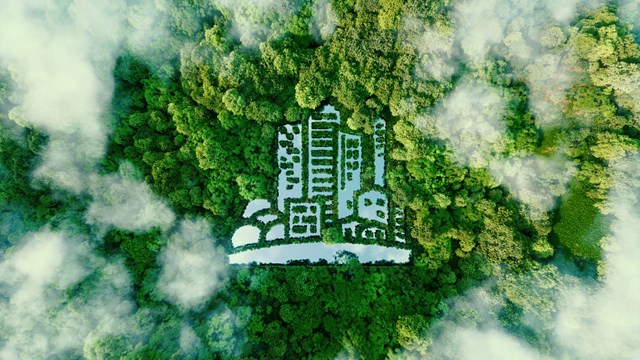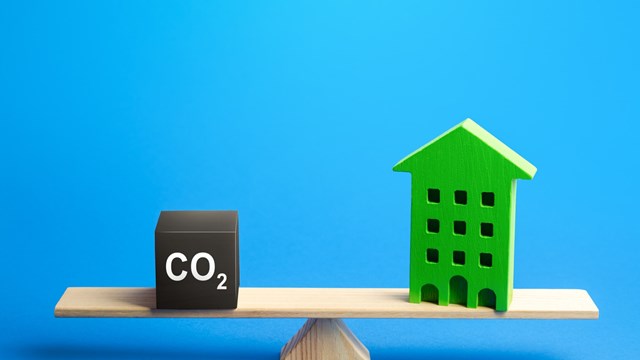Everyone wants to live in a clean building—that's a given. Back in the day, a bucket, mop and a bottle of bleach or ammonia were pretty much all that a superintendent needed when it came to cleaning entry halls, stairwells and other residential common areas. These days however, harsh chemicals and noxious fumes are frowned upon for a variety of reasons—and their place has been taken by an array of more eco-friendly, non-toxic cleaning supplies.
Allergic Risks
According to the American Lung Association, many cleaning supplies or household products can irritate the eyes and the throat, or cause headaches or other health problems. Some products, such as aerosol spray products, air fresheners, chlorine bleach, rug and upholstery cleaners, furniture and floor polish and so forth release dangerous chemicals, including what’s called volatile organic compounds or VOCs. These VOCs contribute to respiratory problems, allergic reactions and headaches.
“There are risks related to using conventional cleaning products,” says Richard Saltzman, executive vice president at Crown Janitorial Products in Yonkers. “If a building is using ammonia-based products they can be a trigger for a variety of health issues. Number one is asthma attacks. Staff members may just be doing their job, using an ammonia-based glass cleaner. They say hi to Mrs. Jones and her son and think nothing of it—then find out later that her son had an asthma attack because he walked through the mist of the cleaner.”
Keeping residents like Mrs. Jones and her son healthy is a primary reason why Aniello DeGuida, building superintendent at The Cocoa Exchange at 1 Wall Street, says that he uses green cleaning products. “Our building is getting a lot of children too,” says DeGuida. “Overall, we want our building to be safer to all of our residents so we use non-allergenic cleaning supplies.”
In addition to the health and well-being of all the residents, converting to greener cleaning products is a positive move for the building staff as well. According to the U.S. Department of Labor’s Occupational Safety and Health Administration (OSHA), an estimated 11 million workers in a wide range of industries and occupations are exposed to at least one of the numerous agents known to be associated with occupational asthma.
The Cost of Green
The biggest misconception about converting current cleaning supplies to more environmentally-friendly products is that it costs more of the other green—as in dollars and cents. Not true, says Saltzman. He says that over the last decade green cleaning products have been completely redesigned and are as effective as their conventional counterparts. “Also, the demand for the product is up there, so the cost is greatly reduced,” he says.
The product demand might be higher but convincing old dogs to try some new tricks can be, well, tricky. “There are plenty of honest salespeople selling used cars,” says Saltzman. “But the knee-jerk reaction to buying green is that the products don’t work as well. They look and smell different than conventional counterparts. In many people’s minds, it’s the blue ammonia products that work best—and it doesn’t matter how much data I can give them. They're creatures of habit.”
When Anselm Doering, the chief executive officer of EcoLogic Solutions in Brooklyn, says that he hears from customers that green products aren’t as affordable or as effective as their traditional versions, he simply rattles off the names of buildings and companies, who use eco-friendly cleaning supplies. “Telling me that they cost more is also the perfect setup for me to show them the products work,” he says.
Seeing might be believing, according to a new study. The demand for solvents in the U.S. is forecasted to increase 1.5 percent per year to $18.4 billion by 2018, according to a new study from industry market research firm The Freedonia Group, Inc. The study attributes the expected growth to a recovery in construction spending, along with a continued rebound in manufacturing output. Additionally, the report forecasts that increases in environmental concerns and regulatory pressure will drive demand for green solvents that are derived from renewable materials.
New Methods
Recently, EcoLogic Solutions received Green Seal certification for a sanitizer/disinfectant for SANeWater, a product that electrolyzes tap water and salt to create a hypochlorous acid solution. “It’s a product that cleans—and you can drink the water too,” says Doering.
It’s produced by the electrolysis of tap water containing dissolved sodium chloride. Combining electrolyzed tap water and salt to create a cleaning solution is becoming more popular and its use is spanning industries. According to an article in the January 2006 issue of Food Production Daily, the system can be used for cleaning equipment in the food industry.
According to ISSA, a cleaning organization, commercial cleaning equipment isn’t certified green, but there are some eco-friendly criteria for some equipment. For example, vacuum cleaners should be certified by the Carpet and Rug Institute's Green Label Testing Program and operate at a sound level of 70dBA; powered floor maintenance equipment (things like electric and battery-powered floor buffers and burnishers, for example) should be equipped with vacuums, guards, and/or other devices for capturing fine particulates and operate with a sound level of less than 70dBA. They also state that propane-powered floor equipment should have high-efficiency, low-emissions engines with catalytic converters and mufflers that meet the U.S. Environmental Protection Agency (EPA) standards for the specific engine size and operate with a sound level of less than 90dBA. Scrubbing machines should use only tap water with no added cleaning products.
Green Seal (greenseal.org) was founded in 1989 “to safeguard the health of people and the planet.” The organization is an independent non-profit providing sustainability certification for more than 375 products and service categories, everything from hotels and restaurants to paints, paper products, and cleaning chemicals. To receive certification, products must meet rigorous performance, health, and environmental criteria based on life cycle research and developed in an open, transparent, and stakeholder-involved process.”
Green cleaning products should be non-petroleum-based and made from biodegradable, renewal resources. There are many green products on the market from which to choose. Look for water-borne, non-toxic, pH neutral, non-hazardous products that contain no solvents, VOCs, alcohol, ammonia, harmful oxygen-based bleach cleaners or citrus-based products that may dissolve rubber or plastics.
For example, when it comes to household cleaners, those certified by Green Seal contain no carcinogens, reproductive toxins or mutagens among other toxic compounds. Animal testing is discouraged and the packaging contains post-consumer content and is recyclable or uses bags/pouches that reduce packaging.
Green products can also be recognized by the EPA’s Design for the Environment (DfE) Safer Product Labeling Program. DfE commends companies for their leadership in designing products that are good for the environment and for their business. According to the EPA website, the DfE Safer Product Labeling Program evaluates products and labels only those that have met the program's highly protective standards. Design for the Environment labels a variety of chemical-based products, like all-purpose cleaners, laundry detergents, and carpet and floor care products. Currently, the DfE program has recognized more than 2,500 products.
“The industry is always going to keep growing,” says Saltzman. “It’s really difficult to do all the research on your own. You need to trust your supplier that you feel will give you the right advice. You also don’t have to be completely green. It might not be for your particular building. But to convert your building and keep it clean, you need to have a partner in the process, not someone just filling an order,” he says.
Saltzman suggests that managers, supers and other building staff make a plan and discuss available product options with the supplier. “Once you sit down with your supplier, you can take baby steps to getting there,” he says.
For managers or supers who are still difficult to convince of the benefits of using green, there is a Green Cleaning Pollution Prevention Calculator (www.responsiblepurchasing.org /janitor/index.asp) which quantifies the projected environmental benefits of purchasing and using "green" janitorial services and products.
Just remember that because a product or system is labeled “green,” “biodegradable,” “eco-friendly,” or “environmentally friendly,” doesn’t mean that it is.
Unfortunately the green industry has seen its share of so-called “greenwashing” by businesses that claim that their company features “green” business practices or that their products are good for the environment, when that's not necessarily the case. How can you tell whether a cleaning product or service is really green? Check with reputable organizations that monitor businesses, like Green Seal. Then you can rest assured that you're doing your greenest for both your building and its staff.
Lisa Iannucci is a freelance writer and a frequent contributor to The Cooperator.










Leave a Comment